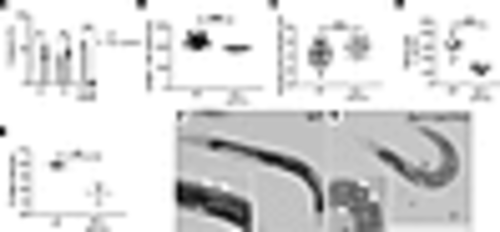Fig. 2
- ID
- ZDB-FIG-220824-73
- Publication
- Lavorato et al., 2022 - Dichloroacetate improves mitochondrial function, physiology, and morphology in FBXL4 disease models
- Other Figures
- All Figure Page
- Back to All Figure Page
|
fbxl-1(ok3741) worms had abnormal development, growth, and fecundity. (A) At 64 hours after eggs were laid, 48% of fbxl-1(ok3741) worms had reached L3 larval development stage and 52% had reached the L4 larval stage. By contrast, 39% of N2 WT worms were at L4 larval development stage and 61% had reached the young adult stage, with no worms seen at the earlier larval stages. n = 168 N2 WT worms; n = 152 fbxl-1(ok3741) worms; 3 biological replicates. (B and C) fbxl-1(ok3741) worm average body length was significantly decreased, and averaged body width was significantly increased, compared with WT worms. n = 54 WT; n = 46 fbxl-1(ok3741). (D) fbxl-1(ok3741) brood size was 58% smaller than that of N2 WT worms. n = 13 N2 WT adult worms; n = 14 fbxl-1(ok3741) adult worms; 3 biological replicates. (E) fbxl-1(ok3741) egg-hatching rate was 21% lower than that in N2 WT worms. n = 136 each strain; 3 biological replicates. (F and G) Images of WT and fbxl-1(ok3741) gravid worms at day 2 of the adult stage. fbxl-1(ok3741) gravid worms have disarranged eggs with differing polarity (G, arrowheads) as compared with WT gravid worms, in which eggs are organized in 1 or 2 layers with similar polarity (F, arrowheads). Data are shown as the mean ± SD. Statistical analyses were performed by Student’s t test. *P < 0.05, **P < 0.01, ***P < 0.001. Scale bar: 400 μm. |

